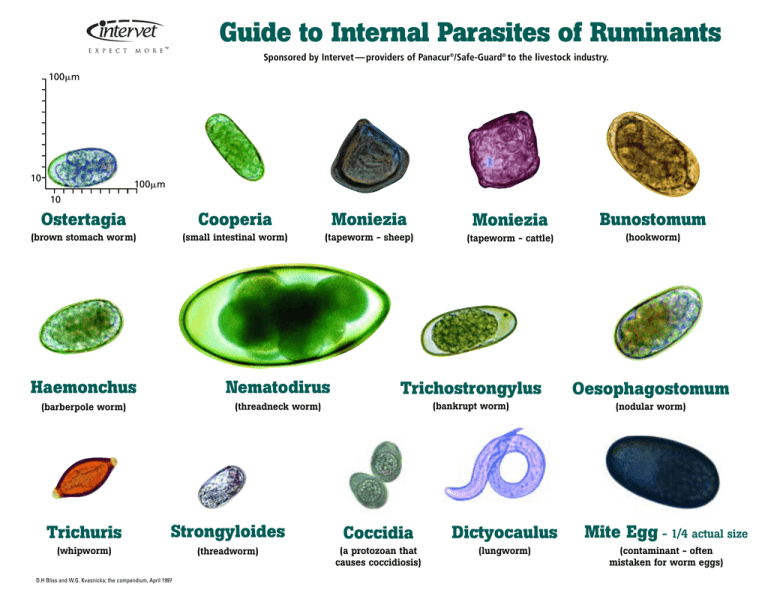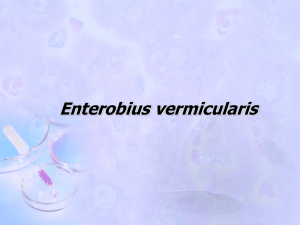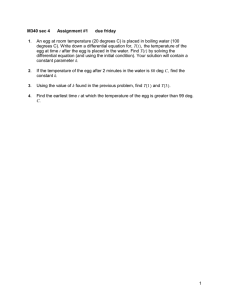Guide to Internal Parasites of Ruminants Bunostomum Ostertagia Moniezia
advertisement

Guide to Internal Parasites of Ruminants Sponsored by Intervet — providers of Panacur®/Safe-Guard®. to the livestock industry. 100mm 10 100mm 10 Ostertagia Cooperia Moniezia Moniezia Bunostomum (brown stomach worm) (small intestinal worm) (tapeworm - sheep) (tapeworm - cattle) (hookworm) Haemonchus Nematodirus Trichostrongylus Oesophagostomum (barberpole worm) (threadneck worm) (bankrupt worm) (nodular worm) Trichuris Strongyloides Coccidia Dictyocaulus Mite Egg - 1/4 actual size (whipworm) (threadworm) (a protozoan that causes coccidiosis) (lungworm) (contaminant - often mistaken for worm eggs) D.H Bliss and W.G. Kvasnicka; the compendium, April 1997 Health Impact and Characteristics of Internal Parasites Approximate Length (mm) Parasite Ostertagia (brown stomach worm) n Supresses appetite n Weight loss, poor body condition Haemonchus (barberpole worm) n Anemia n Death common in sheep and goats Trichostrongylus (bankrupt worm) n Watery diarrhea n Slowed growth Cooperia (small intestinal worm) n Diarrhea n Slowed growth Nematodirus (threadneck worm) n Diarrhea n Slowed growth n Emaciation and death in sheep, young cattle Oesophagostomum (nodular worm) n Diarrhea n Slowed growth Bunostomum (hookworm) n Anemia n Weight loss Strongyloides (threadworm) n Diarrhea in young n Fatal infections reported in young raised on sawdust Trichuris (whipworm) n Reduced appetite n Slowed growth Coccidia n Bloody diarrhea in young cattle n Reduced weight gains in sheep, goats, cattle n Death can occur in calves, lambs, kids and adult goats Moniezia (tapeworm) n Blocks small intestine in lambs n Loss of nutrients Dictyocaulus (lungworm) n Cough n Reduced appetite and milk production 29160 Intervet Lane • P.O. Box 318 • 60-70 Characteristics Medium-sized, standard strongyle egg; barrel-shaped sidewalls; large number of blastomeres nearly fills egg 85 Larger and rounder than Ostertagia egg; blastomeres more easily seen than in Ostertagia 85 Often shaped like a kidney bean; one side is more rounded than the other; there is usually a lot of clear space within the egg Medium-sized egg with parallel sides and numerous blastomeres that are hard to distinguish 75-85 200 Large egg; looks like an American football with basketballs inside; two to eight large blastomeres are surrounded by a fluid-filled cavity 95 Medium-sized to large egg; about one and a half times the size of the Ostertagia egg: 16 to 32 blastomeres; are easier to see than those of Haemonchus Medium-sized to large egg; four to eight blastomeres; sometimes the walls are thick and rectangular 100 40-65 75 Small egg with a thin shell containing an L1 larva that can be seen under low power Egg is shaped like an American football and has two protruding polar caps; the shell is double and thick Modified Wisconsin Sugar Fecal Worm Egg Flotation Method 1 2 Measure 3 grams of fecal material into a 3-5 oz. paper cup 4 3 15ml sugar solution is added to fecal matter 5 Pour mixture into tea strainer and collect in 3-5 oz. cup 7 6 Use a tongue depressor to press as much material through strainer as possible 8 Place tube in rack and top off with sugar solution (forms a meniscus) Cover with 22x22 mm cover slip and set aside for 2-4 mins Stir solution and fecal matter until material has even consistency Pour strained mixture into a conical/ graduated 15 ml centrifuge tube Place tube into centrifuge at 800-1000 rpm for 5-7 mins 9 Lift cover slip directly upward and immediately place on microscope slide Use microscope to scan entire cover slip for egg count 1. Fecal samples can be stored for long periods if refrigerated (not frozen). 2. Sugar solution is prepared by adding 1 lb. of sugar into 12 fluid oz. (355 ml) of hot water: stir until all sugar is dissolved. 16-47 Coccidia appear small in size, pink in color; size and shapes vary depending on species 3. Slides can usually be placed in the refrigerator for several days prior to reading. 4. Identify parasites present: 80x80 Quadrangular; somewhat irregular; contains a circular or pear-shaped apparatus at one end 6. Materials needed: 450 Rectal sample of feces needed for positive identification; L1 larva found in feces; flattened head and tail end in blunt point Millsboro, Delaware 19966-0318 Panacur and Safe-Guard are registered trademarks of Intervet Inc. ©2004 Intervet Inc. • 4/04 • BV-SG #18475 +(1-10 eggs/sample) ++(11-50 eggs/sample) +++(over 50 eggs/sample) 5. # of eggs found x 150 = # of eggs per pound feces • intervetusa.com • 800.441.8272 a. Sugar solution plus dispensing bottle, gun, or syringe e. Taper-bottom test tubes f. Test tube rack b. Tea strainer g. Standard microscope slides c. 3 oz. and 5 oz. Dixie cups h. Centrifuge d. Tongue depressors k. Microscope



